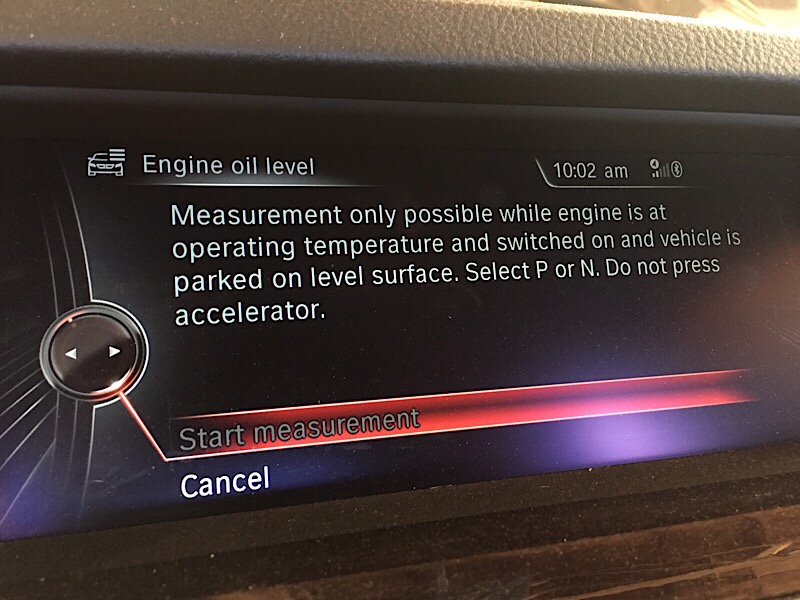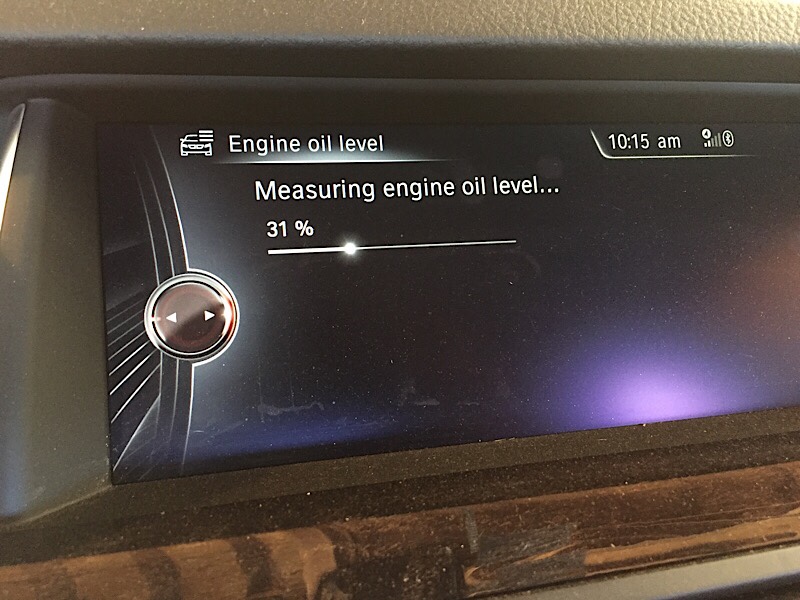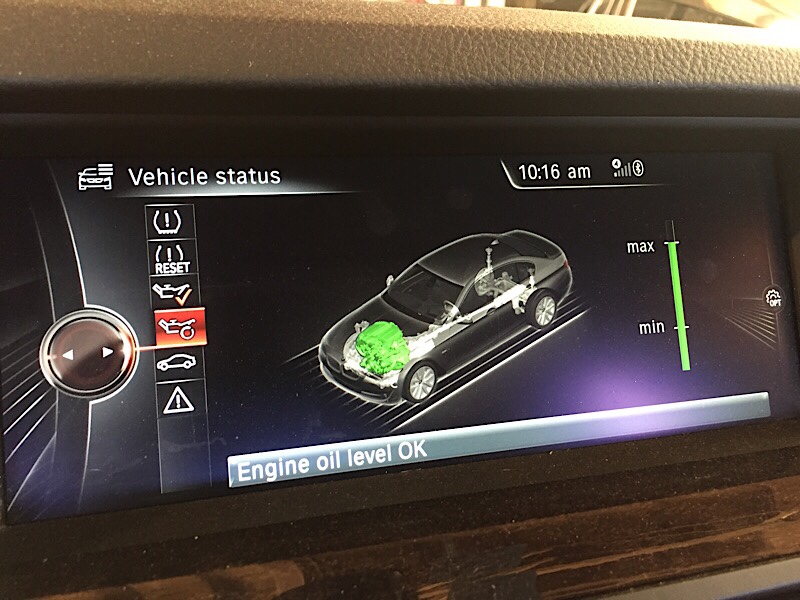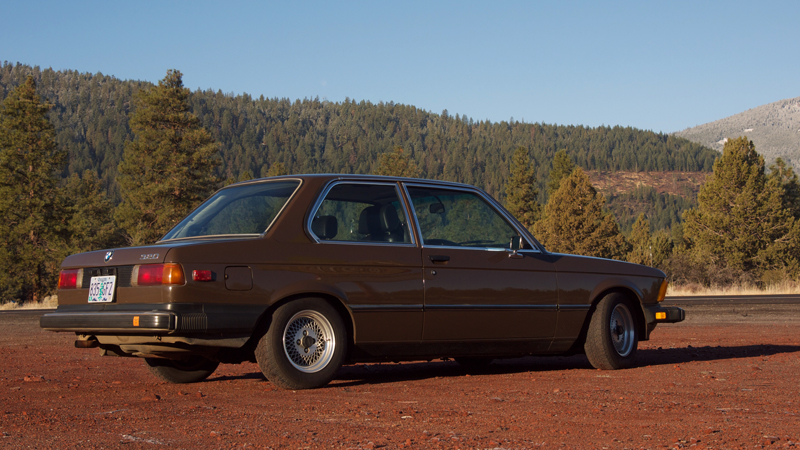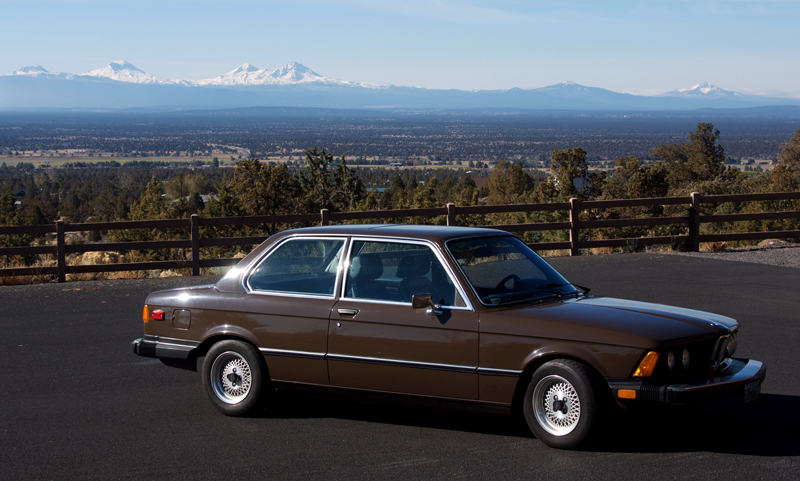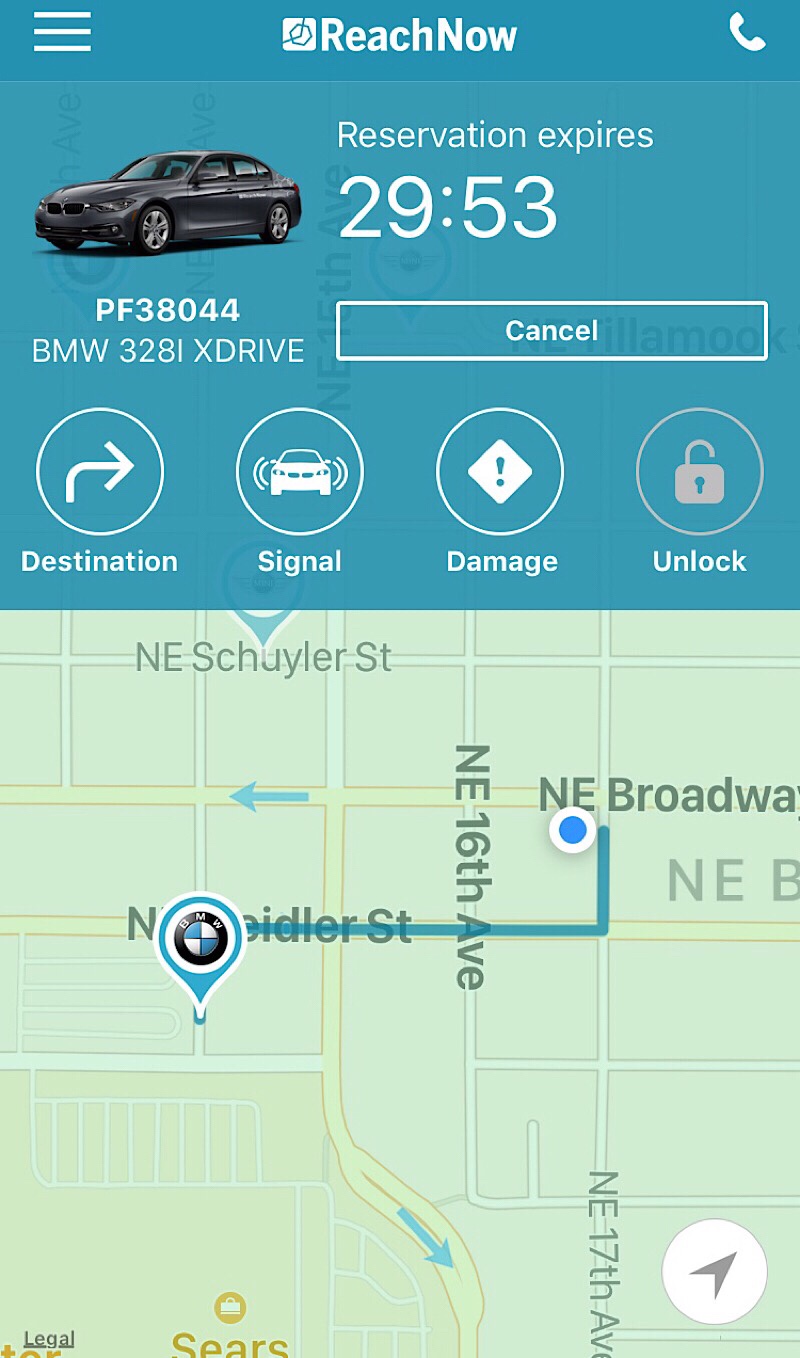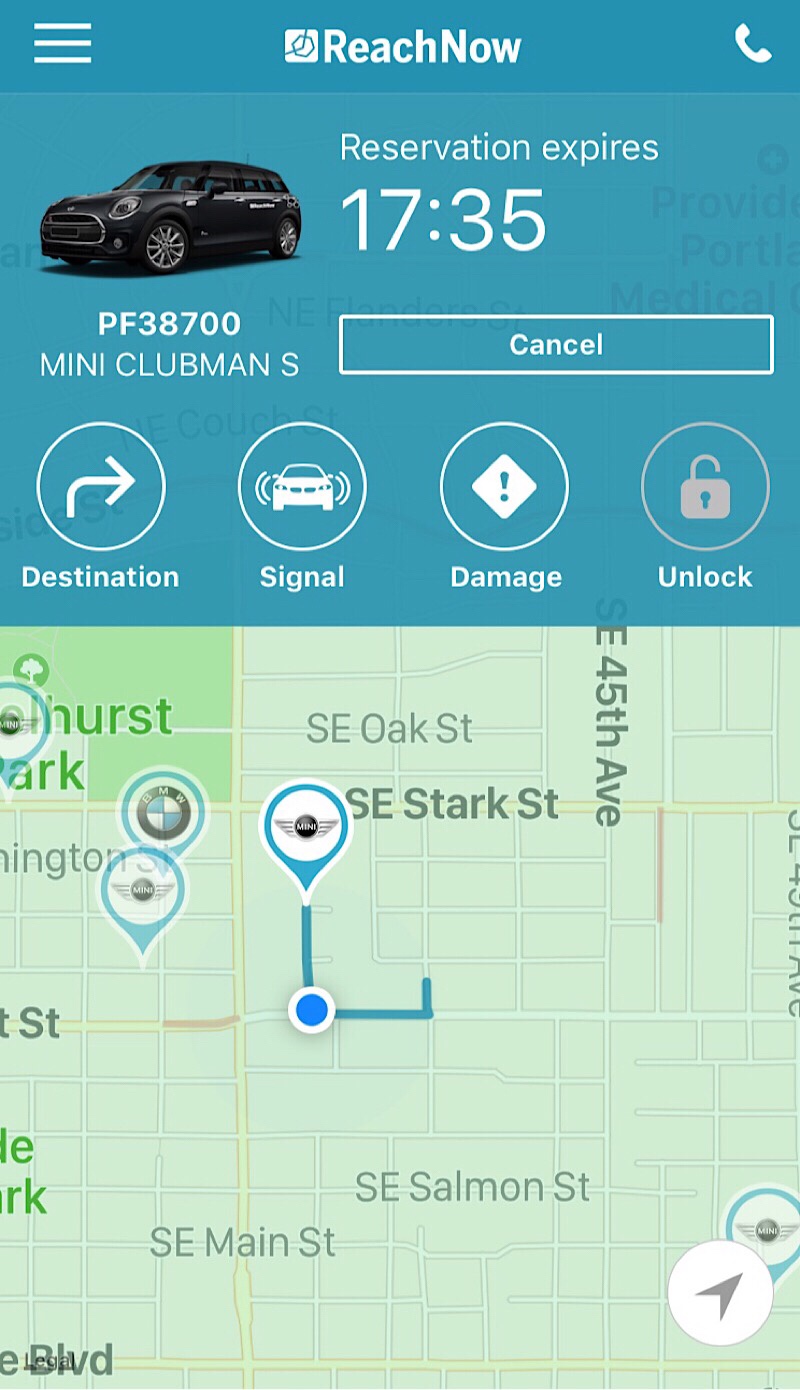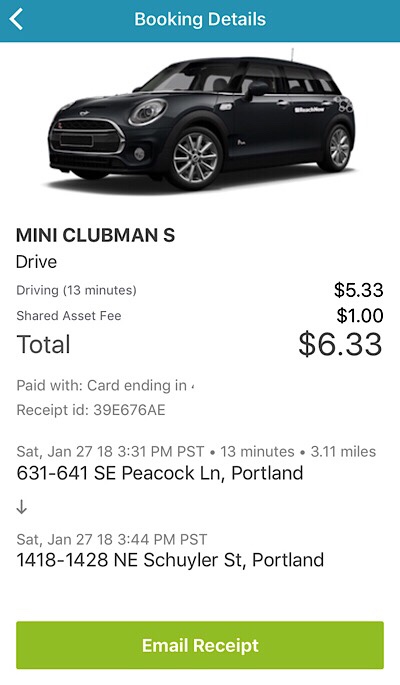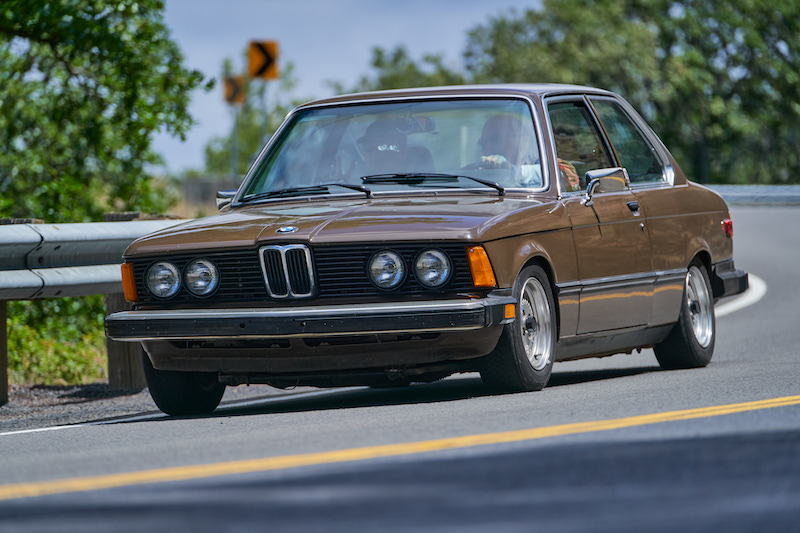
I turned 15 years old in October of 1979 and started to learn to drive in my mother’s ’77 Buick LeSabre. Right about that time this 320i was on its way from Munich, West Germany to Salem, Oregon, where it was delivered to the original buyer, who ordered it probably several months beforehand, and yearned for it to arrive. They had specified several high end options (most of which later were bundled into a new model, called 320is at the end of the E21 run, when next 3-series, the e30 was on the horizon) such as Recaro sport seats, BBS wheels, wooden shift knob, A/C, and an upgraded handling package. All wrapped in such an awesome seventies Sepiabraun paint color.
My mom’s Buick had a ~5 liter V-8 (yet still seemed wheezy and sluggish, as all Malaise-Era Detroit machines did), the slushiest of slushboxes, and probably as much extra weight as this entire little BMW sports coupe. I really wanted a car like the 320i, with its nimble handling, sparse, but functional interior, forward-opening hood, and U-boat inspired red dash illumination. But instead I was driving a monstrous barge of a Buick, that could only top the little BMW in perhaps one index of performance: A/C output. I’ve always believed that the world’s finest air conditioners are provided by General Motors, wrapped by immensely mediocre vehicles. Mom’s Buick was that, to a “T”.
I read about BMWs in my father’s Road & Track, and Car and Driver magazines. The writers always proclaimed the BMW 3-series as “A Driver’s Car” with tales of delightful responsiveness and handling. BMW ads in those magazines told about how they hand-crafted every car, and manufactured in one year, as many cars as Detroit churned out every day. They built them carefully, and with perfection in mind. In other words everything my mom’s Buick could never be. Those little Bimmer coupes just seemed like such a cool compromise between a sports car, and something practical. You could put four or five average 1970s-sized Americans into one, and fill the giant trunk with luggage, or groceries, or BOTH, and still have fun driving it around.

Practical Fun indeed. It is clear the original owner loved this car. They made a few tasteful, period-correct modifications to it, including lowering springs, and replacing the Mahle-BBS gold/silver basketweave wheels with a set of Enkei silver basketweaves. The fog lights disappeared at some point; though wires and switchgear remain. The car spent its entire life in Central Oregon, and I even saw it from time to time when I was driving my son Nick to Bend High School circa 2011-12. The original Owner’s family sold it on Craigslist, to a guy in Portland. Shortly thereafter, that guy moved to Los Angeles for a new job and discovered that this car can’t be registered in California without some modifications to make it pass an emissions test (it is from the “49 State Car” era, when manufacturers made California-specific models.) Since it is a remarkably original car, he made the decision to sell it, on the then-nascent Bring A Trailer auctions. I bought it on a whim really. It was (relatively) cheap, and something that I had always wanted since those days of driving my mom’s Buick.
Up until a decade ago, I had never actually driven a BMW. Shocking I know. My garage had been mainly a Volkswagen sanctuary, with half of those being Diesels. I’ve driven Jaguars, Porsches, and a whole bunch of Mercedes-Benzes (including the 300sl), and a bunch of other machines, but for some reason BMW was something I’d yet to drive. That changed in 2011 when I not only drove a BMW, in this case the iconic successor to the 320i, the E30/325i, but this first driving experience was also on a racetrack, in wheel-to-wheel competition!
It was on that weekend that I finally experienced “The Ultimate Driving Machine”. It was worth the wait. I had a blast throwing that little coupe around the track. It was fast, fun, nimble, and everything I had imagined the BMW driving experience to be. The predictable and easily controllable oversteer was the icing on the cake. Mind you the interior was stripped to bare metal and I was surrounded by a roll-cage, so I wasn’t getting the full picture, but what I did get was as addictive as crack. I bought myself a BMW within a year.

When I saw this brown E21/320i on Bring A Trailer, I was inspired to bid on it. Not only because it was a BMW, but it was also an under-appreciated classic, and needed to return home to Central Oregon. Over the past several years it has become my favorite car for a Sunday drive. It never fails to bring a huge smile to my face. Sure, it is a tad under-powered, but it is a rocket-ship when compared to the cars I drove back in those days… the aforementioned Mom’s Buick, and the first car I ever called my own, a 1980 VW Rabbit Diesel. The Buick had nothing but bulk, and noise, and ice-cold A/C. The VW had 40 HP and a spare, Teutonic gestalt. It was like a tiny fraction of a BMW 320i. 0-60 measured in minutes, but a lot of room on the inside in a small, lightweight chassis.
What makes the 320i so fun to drive is it just feels so tossable. Like an extension of your mind, wrapped in a Paul Bracq sculpture. It is beautiful, practical, fun, and above all else, an icon of 20th Century Industrial Design. It makes all the right noises. It provides all the right feedback. What it lacks in sensuous curves and impracticality, it makes up in spades with functionality and fun. They’re from an era when “adding lightness” was on top of every automotive engineer’s mind – mostly for a shortcut to fuel economy, but the Germans did this better than anyone. They didn’t just shrink big cars, they designed small cars to be what they could and should be.
In other words, everything my mom’s Buick never was.
The car brings a remarkable number of thumbs-up and appreciative waves from a fairly wide demographic on the road and in parking lots. The color, the design, the 13″ wheels, and the quad headlights just proclaim to the world “Late Twentieth Century!” in such firm and Germanic language. Unlike the “Cindy” E30/325, and the “Marsha” 2002, the “Jan” E21/320 is late to being recognized for the prize it really was for BMW. It saved the brand, and was the first chassis to sell a million units for them. Sadly, so few remain, and especially those in such excellent, original condition.
